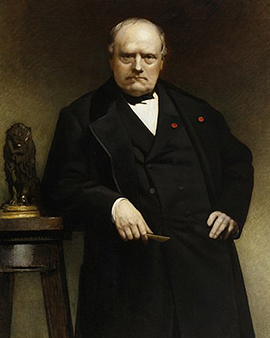The French sculptor Antoine-Louis Barye spent most of his life and artistic work in Paris. His father was a goldsmith, which is why he came into contact with the techniques of working with precious metals at an early age. At the age of 14 he began his training as a metal engraver, which he had to finish due to the political situation at that time. During Napoleon's Russian campaign in 1812, Barye joined the army on the staff of the Corps of Engineers. He helped to draw fortress plans. Two years later, Antoine-Louis Barye was able to leave the army again. He began training as a chaser. This profession is also in the field of metalworking. About two years later, his professional career as a pupil led him to the famous sculptor Francois Joseph Bosio. In 1817 Antoine-Louis Barye was admitted to the studio of the painter Antoine Jean Gros. The following year he received the first prize for one of his works of art and was accepted into the École des Beaux-Arts. Due to differences of opinion between institutions such as the École des Beaux-Arts or the Paris Salon, he refused to exhibit further works. During this period he worked for the goldsmith and jeweller Jacques Henri Fauconnier. Fauconnier claimed some of Barye's works as his own.
It was not until 1831 that Antoine-Louis Barye again devoted himself more to artistic activities and exhibited sculptures and watercolours. The French artist was strongly inspired by the animal world. Illustrations and sculptures of lions and tigers were among his preferred representations. Dramatic illustrations, for example a lion devouring an alligator, are characteristic of his works. With this sculpture, Barye caused quite a stir among the public. After all, such representations were rather untypical for the time. Later, Barye was also very successful in lithography. His sculptural works belong to the epoch of realism. Detailed and natural-looking representations make his sculptures and sculptures stand out. A precise power of observation was an important basis for his artistic work. In the Jardin des Plantes and in the Natural History Museum in Paris he spent a lot of time gathering impressions for his precise representations of nature.
Antoine-Louis Barye was not only an artist but also a successful entrepreneur. In 1837 he founded a company with a partner that developed models for sculptures and bronzes. At that time, he received numerous well-paid government commissions. It was not until 1848 that his entire artistic oeuvre received wide general recognition. In the mid-1850s he began to give courses in zoological drawing as a professor at the Natural History Museum. His graphic works, sculptures and watercolours are still of art-historical significance today. Barye broke new ground with his works and had a decisive influence on a new art epoch. Many of his models and smaller bronzes are in the possession of the Museum in Luxembourg and can be admired there in their original form.
×





.jpg)
.jpg)
.jpg)
.jpg)
.jpg)
.jpg)
 - (MeisterDrucke-180120).jpg)
 - (MeisterDrucke-180120).jpg)
_19th_-_(MeisterDrucke-1058140).jpg)
_19th_-_(MeisterDrucke-1058140).jpg)
.jpg)
.jpg)
.jpg)
.jpg)
 c1835 (black chalk on tracing paper mounted to - (MeisterDrucke-648979).jpg)
 c1835 (black chalk on tracing paper mounted to - (MeisterDrucke-648979).jpg)
 - (MeisterDrucke-69089).jpg)
 - (MeisterDrucke-69089).jpg)
.jpg)
.jpg)
.jpg)
.jpg)
 - (MeisterDrucke-35985).jpg)
 - (MeisterDrucke-35985).jpg)
_-_(MeisterDrucke-590160).jpg)
_-_(MeisterDrucke-590160).jpg)
 - (MeisterDrucke-125291).jpg)
 - (MeisterDrucke-125291).jpg)
.jpg)
.jpg)
 - (MeisterDrucke-240682).jpg)
 - (MeisterDrucke-240682).jpg)
_-_(MeisterDrucke-590158).jpg)
_-_(MeisterDrucke-590158).jpg)
.jpg)
.jpg)
_-_(MeisterDrucke-590162).jpg)
_-_(MeisterDrucke-590162).jpg)
_-_(MeisterDrucke-379591).jpg)
_-_(MeisterDrucke-379591).jpg)
_-_(MeisterDrucke-1490942).jpg)
_-_(MeisterDrucke-1490942).jpg)
.jpg)
.jpg)
.jpg)
.jpg)
_-_(MeisterDrucke-67325).jpg)
_-_(MeisterDrucke-67325).jpg)
.jpg)
.jpg)
.jpg)
.jpg)
.jpg)
.jpg)
.jpg)
.jpg)
.jpg)
.jpg)
.jpg)
.jpg)
.jpg)
.jpg)
.jpg)
.jpg)
.jpg)
.jpg)
_-_(MeisterDrucke-590159).jpg)
_-_(MeisterDrucke-590159).jpg)
.jpg)
.jpg)
.jpg)
.jpg)
.jpg)
.jpg)
_-_(MeisterDrucke-1129210).jpg)
_-_(MeisterDrucke-1129210).jpg)
_(front_view)_-_(MeisterDrucke-1133444).jpg)
_(front_view)_-_(MeisterDrucke-1133444).jpg)
.jpg)
.jpg)
.jpg)
.jpg)
_(see_also_226321)_-_(MeisterDrucke-1126953).jpg)
_(see_also_226321)_-_(MeisterDrucke-1126953).jpg)
_-_(MeisterDrucke-588054).jpg)
_-_(MeisterDrucke-588054).jpg)
.jpg)
.jpg)
.jpg)
.jpg)
_-_(MeisterDrucke-590156).jpg)
_-_(MeisterDrucke-590156).jpg)
_-_(MeisterDrucke-1128180).jpg)
_-_(MeisterDrucke-1128180).jpg)
.jpg)
.jpg)
_-_(MeisterDrucke-910555).jpg)
_-_(MeisterDrucke-910555).jpg)
.jpg)
.jpg)
.jpg)
.jpg)
.jpg)
.jpg)
_-_(MeisterDrucke-1059197).jpg)
_-_(MeisterDrucke-1059197).jpg)
.jpg)
.jpg)
 - (MeisterDrucke-64608).jpg)
 - (MeisterDrucke-64608).jpg)
_-_(MeisterDrucke-590155).jpg)
_-_(MeisterDrucke-590155).jpg)
.jpg)
.jpg)
.jpg)
.jpg)
.jpg)
.jpg)
.jpg)
.jpg)
.jpg)
.jpg)
.jpg)
.jpg)
.jpg)
.jpg)
.jpg)
.jpg)
.jpg)
.jpg)
.jpg)
.jpg)
.jpg)
.jpg)
.jpg)
.jpg)
.jpg)
.jpg)
_-_(MeisterDrucke-910297).jpg)
_-_(MeisterDrucke-910297).jpg)
.jpg)
.jpg)
.jpg)
.jpg)
.jpg)
.jpg)
.jpg)
.jpg)
.jpg)
.jpg)
.jpg)
.jpg)
_-_(MeisterDrucke-1311363).jpg)
_-_(MeisterDrucke-1311363).jpg)
_-_(MeisterDrucke-590141).jpg)
_-_(MeisterDrucke-590141).jpg)
_-_(MeisterDrucke-1311362).jpg)
_-_(MeisterDrucke-1311362).jpg)
.jpg)
.jpg)
.jpg)
.jpg)
_-_(MeisterDrucke-590161).jpg)
_-_(MeisterDrucke-590161).jpg)
.jpg)
.jpg)
_-_(MeisterDrucke-1099457).jpg)
_-_(MeisterDrucke-1099457).jpg)
.jpg)
.jpg)
.jpg)
.jpg)
.jpg)
.jpg)
_-_(MeisterDrucke-1133061).jpg)
_-_(MeisterDrucke-1133061).jpg)
.jpg)
.jpg)
_-_(MeisterDrucke-1338224).jpg)
_-_(MeisterDrucke-1338224).jpg)
.jpg)
.jpg)
_-_(MeisterDrucke-1129213).jpg)
_-_(MeisterDrucke-1129213).jpg)
.jpg)
.jpg)
.jpg)
.jpg)
_-_(MeisterDrucke-1133443).jpg)
_-_(MeisterDrucke-1133443).jpg)
.jpg)
.jpg)
_-_(MeisterDrucke-1540766).jpg)
_-_(MeisterDrucke-1540766).jpg)
_Studies_of_Animals_(verso)_-_(MeisterDrucke-1311361).jpg)
_Studies_of_Animals_(verso)_-_(MeisterDrucke-1311361).jpg)
.jpg)
.jpg)
.jpg)
.jpg)






